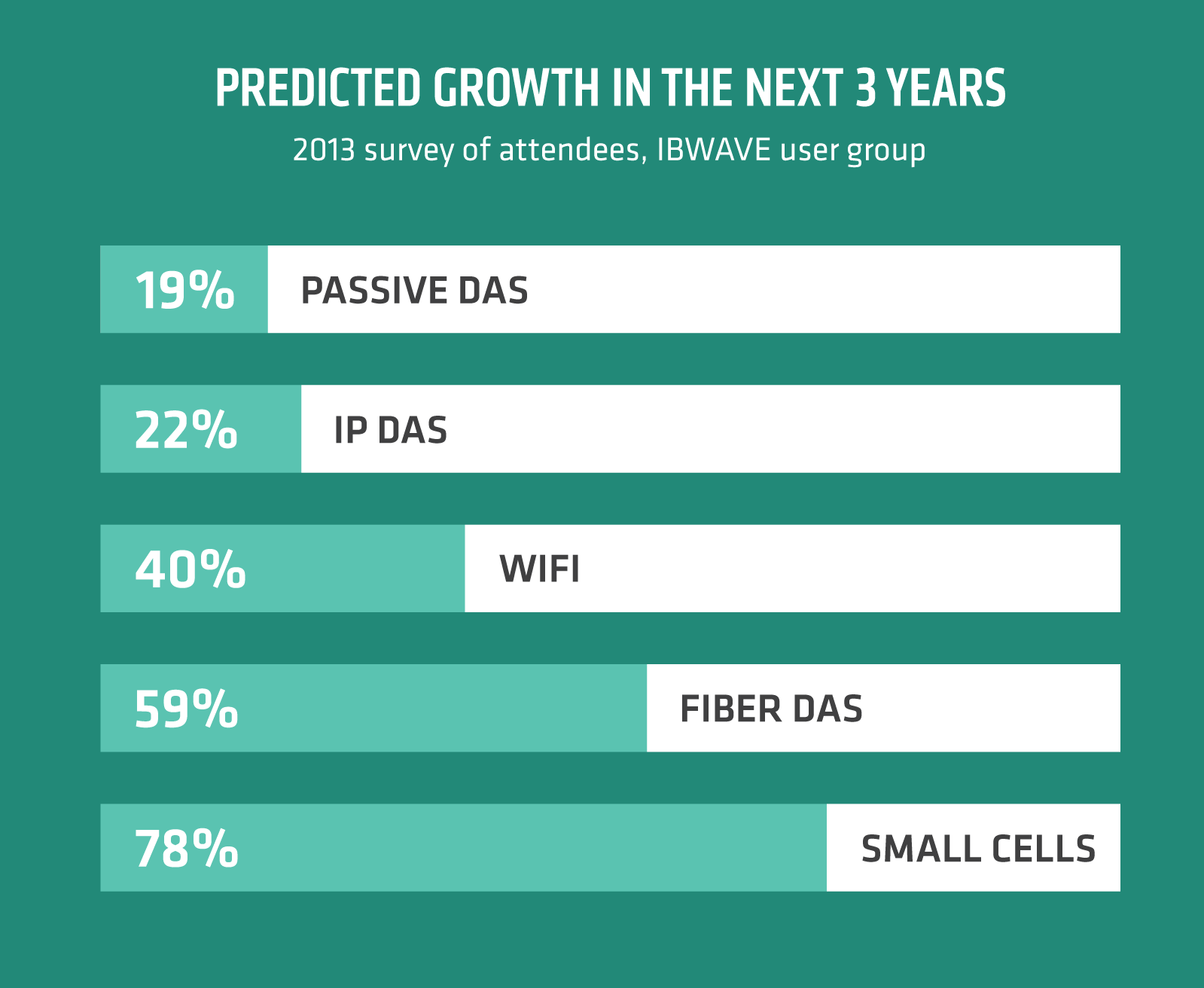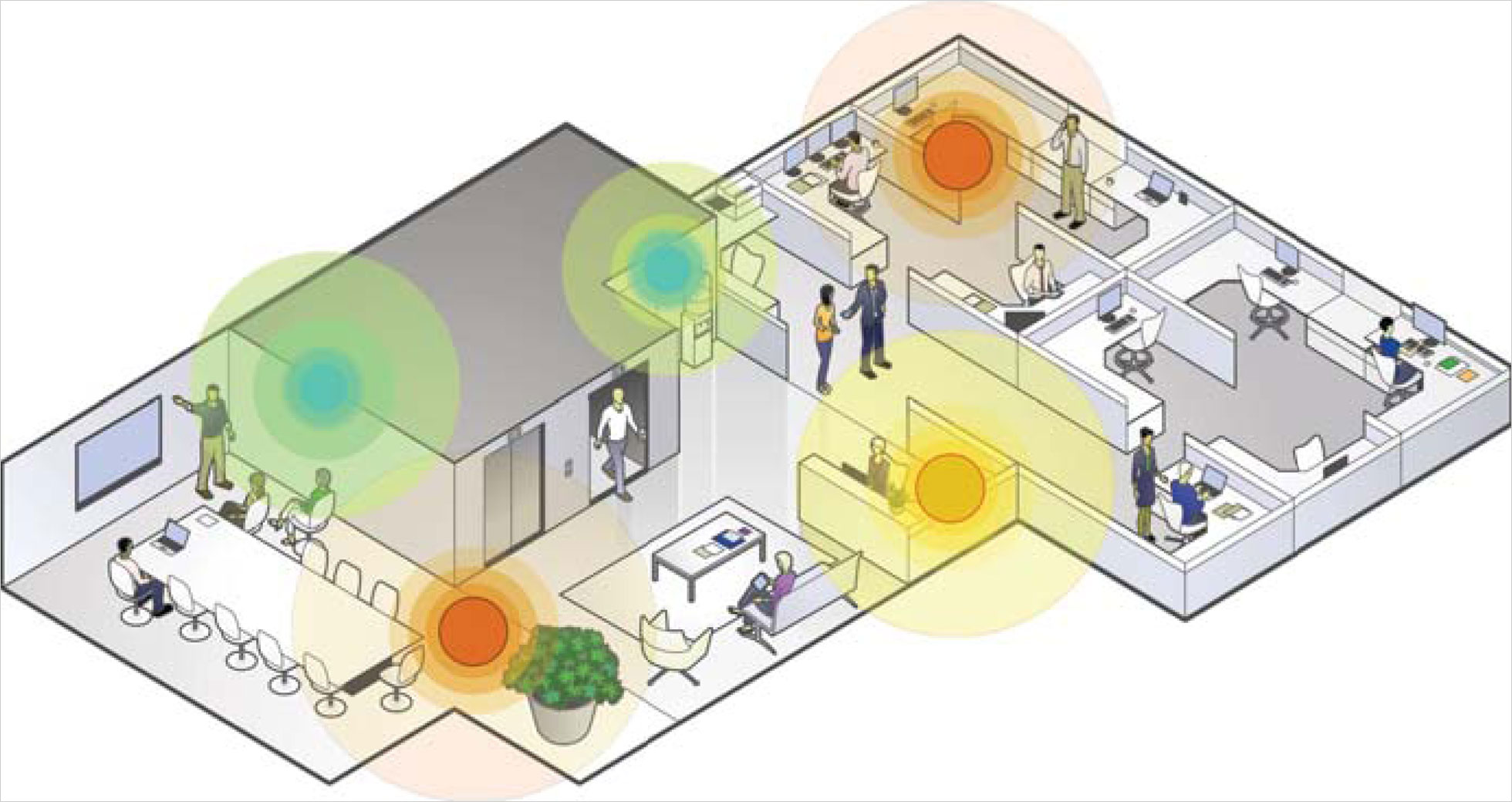The Technological Future of Small Cells
Share

Small cell technology has been a hot topic for the past few years. There is virtually unanimous agreement among industry experts that this is the wave of the future for the wireless industry. AT&T’s forecast, for example, predicts that in 2014, small cell deployments will outnumber distributed antenna system (DAS) deployments by a 40-to-1 ratio. Figure 1 presents a relative comparison of small cell growth over other options for managing the predicted data onslaught. All this points to a bright future for small cells, but there are technical challenges that must be faced in order to implement large-scale, small cell integration into 4G mobile networks. Fortunately, technological advancements, such as heterogeneous networks (HetNets) and self-organizing networks (SONs), will enable universal small cell deployments.

FIGURE 1. SMALL CELLS VS. OTHER COMMUNICATIONS TECHNOLOGY OPTIONS.
WHERE SMALL CELL BEGAN: WIRELESS “GOLD RUSH”
It began with the FCC’s PCS spectrum band auction in 1995, which is generally considered the beginning of the digital mobile wireless era in the United States. The auctioned spectrum was made available specifically for new digital wireless protocols, such as IS-95 (CDMA), GSMA and IS-136. Because the new protocols were cheaper to deploy and had much greater user capacity than the older analog protocol, the mobile wireless industry suddenly became more lucrative. The next few years were “gold rush” years, with carriers competing to be the first to launch their own nationwide networks. At the time the primary network design goal was to provide ubiquitous signal coverage, namely, five bars everywhere all the time. This meant that a typical cell site had big directional antennas 150 to 200 feet above the ground, and had a range of up to a mile in urban areas and a few miles in suburban areas. These macrocells, which primarily cover roads and outdoor public areas, are known as the macro network.
THE BIRTH OF SMALL CELLS
As the calling plans became cheaper, user penetration skyrocketed, and by the late ’90s operators started to look for ways to increase the capacity of their networks. Increasing
cell site sectorization (cell splitting) and reducing the height of cell sites were early solutions for capacity shortages. Next came picocells, which had significantly smaller output power, less capacity and a smaller form factor than macrocells, and were also less expensive. As smartphones proliferated in the second half of the ’00s, the subscriber usage pattern shifted from voice calls, made outdoors or in a vehicle, to data download/upload made indoors while being stationary or semi-stationary. Thus, a need for a third type of cell was born, a cell that would be capable of transmitting indoors at a power level comparable to that of a mobile device, and would have a form factor comparable to that of a Wi-Fi modem. Those were first known as femtocells, but have since been consolidated with picocells under the “small cells” moniker.
SMALL CELLS TODAY
Today’s 4G mobile network macrocells are up to 100 feet high, and are typically located on rooftops, providing umbrella coverage to a large area. Conversely, outdoor small cells are typically found mounted on lampposts or sides of buildings, 10 to 15 feet above the ground and provide capacity to customers nearby using a much smaller footprint. Small cells are also found inside structures, providing coverage and capacity in reception areas, lobbies and store fronts, as well in enterprise offices on higher floors (see figure 2). The integration of small cells and macrocells is generally defined as a HetNet. Thanks to the inclusion of small cells within HetNets, this new paradigm will offer an unprecedented set of challenges related to how they are planned, deployed, optimized and operated.

FIGURE 2. TYPICAL LOCATIONS FOR SMALL CELLS WITHIN THE HETNET.
CHALLENGES OF HETEROGENEOUS NETWORKS
Deployment Dynamics
Macro networks are designed by engineers and optimized by RF technicians in a process that is predominantly manual and can take weeks. This is a costly process that requires skilled RF labor. The sheer number of small cells in a HetNet dictates a design and deployment process that is primarily field driven, where a cluster of small cells is designed and optimized by IT personnel in a matter of hours. This is an inherently low-cost process done by personnel not skilled in RF; because of that, the design and planning tool used for small cells has to be simple to use and inexpensive. It also has to be tablet friendly, because most small cell designs will be completed on the spot, during a site visit. RF optimization tools have to be self-optimizing and have to have self-healing capabilities. That means having the ability to self-diagnose and fix most common network problems without human intervention. Because of the projected scale of small cell deployments, streamlining the approval process is going to be crucial in order to properly manage the deployments.
Real Estate
Space is at a premium on lampposts, traffic lights and other types of street furniture on which small cells may be mounted outdoors. While lampposts and traffic lights are typically owned by utility companies, it is the local government that sets the rules for their secondary use, such as cell site location. Generally, municipalities tend to be restrictive and rarely allow more than one set of antennas/transmitters on street furniture. Likewise, for aesthetic reasons, building managers are reluctant to allow each carrier to mount their own cluster of in-building small cells. This is a much different situation than what operators faced with macro networks, where there was always enough space to collocate antennas on a tower or on top of a multistory building. Operators now need to increasingly work together in order to deploy neutral host networks and maximize the limited amount of small cell real estate available to wireless network equipment.
Backhaul
With LTE Advanced data rates reaching 1 Gb/s, there is only one technology currently capable of providing backhaul for those data rates at 99.999% (the so called “five nines”) reliability, and that is optical fiber. While macro cells may get fiber backhaul, the sheer number of small cells needed to get deployed is a near guarantee that only a fraction of them may be eligible for fiber backhaul. Extending fiber to all outdoor small cells is cost prohibitive, as it costs a few thousand dollars per meter in most metropolitan areas. An alternative solution at slower data rates is fixed wireless backhaul. Fixed wireless backhaul can be microwave backhaul, point-to-multipoint local multipoint distribution service (LMDS), wireless mesh or free space optics. Each has its own limitations: microwave backhaul and LMDS require line of sight; LMDS is sensitive to rain; wireless mesh data rates are comparatively much lower than the other two; and free space optics, while capable of delivering data rates comparable to fiber, is limited by line of sight requirements and is also sensitive to fog and snow. However, as pressure mounts to provide small cell networks, backhaul solutions will continue to evolve and there is little doubt that backhaul issues will be resolved. They have to be because without cost-eff ective, reliable and sufficient backhaul, nothing will work.
Truck Rollout
Mass deployment of small cells is only commercially viable if the installation and commissioning process is much simpler and faster than deploying macrocells. Most low-power in-building small cells need to have plug-and-play installation, so that IT managers or building managers can complete the process themselves. Rolling out a truck with technicians for installation and commissioning should be done only if outdoor small cells or a large cluster of indoor small cells are being deployed.
Interference
Interference is a challenge that has large-scale ramifications. While there are different types of interference issues within HetNets, most important is to maintain throughput and data rates. When there are a large number of small cells in a HetNet, it means that cell site density is a couple of orders of magnitude higher than in macro networks. High cell density means that many sites will have their signal above the threshold at a mobile’s receiver. While being close to a cell site means that the serving signal is good (five bars), if a cell phone “hears” many non-serving cell sites, then it experiences a high level of interference. This is significant because signal to interference and noise ratio (SINR) determines data rates, and high interference implies low SINR and slow data rates. Thus, without some kind of intelligent interference control or cancellation, the benefit of being close to a cell site quickly disappears even at a short distance away. This may leave customers frustrated, because when they see five bars they automatically assume that their data connection should also be fast, when in reality it is not.
Handoff
Because of the significant increase in cell site density, the handoff between small cells occurs much more often than the handoff between macrocells, so handoff algorithm has to be tight, fast and accurate. More handoff s mean that handoff signaling traffic significantly increases as well. Signaling traffic is already much heavier in 4G networks than in any previous networks because smartphone applications need to periodically communicate with websites to provide application updates. Therefore, adding more traffic for handoff signaling makes the possibility of reaching a signaling capacity limit in a cell a challenging reality. Once that happens, the network refuses data connections even though there may not be very many users running active data sessions. This effectively reduces network capacity and slows the average data rate per cell.
CRITICAL FACTORS FOR SMALL CELL ADOPTION
These challenges are the consequence of economies of scale. For small cells to live up to their true potential, HetNets have to be designed, deployed and operated in a far more efficient manner than macrocell networks. It is the author’s opinion that the efficiency in these networks can be achieved if the following methods are part of the network deployment:
Neutral Host Cell Sites/Neutral Host Network Operators
Because of the lack of real estate for outdoor small cells, collocating multiple small cells may not always be possible, and operators may be forced to house multiple wireless
operators under one small cell enclosure. Such a cell site is called a neutral host cell site, and a strategy wherein wireless operators share a cell site is called a neutral host deployment. Large-scale neutral host deployment may give rise to a new class of wireless operators: neutral host network operators. They will be known as network operators despite the fact that they don’t hold spectrum, because they will plan, design, deploy and operate a cluster (or even a small network) of neutral host cell sites, and charge wireless spectrum holders, namely, macro mobile network operators, an operational monthly fee. Having a third party install and operate a portion of the network for a fraction of the cost would help reduce capex for macro mobile network operators.

FIGURE 3. TYPICAL NEUTRAL HOST, IN-BUILDING SMALL CELL INSTALLATIONS.
Dedicated Spectrum Allocation for Small Cell Networks
To control and reduce handoff traffi c to and from macrocells and to mitigate interference from macrocells, a separate spectrum band needs to be dedicated for small cell deployments. Having two separate spectrum bands would then separate a HetNet into two networks: a macro network and a small cell network. This would help control the traffic flow between the two, reduce overall interference in each network and also limit the handoff between the two. The FCC has recognized a need for a small cell spectrum band and has recently created an initiative to allow small cells to share 3.5 GHz spectrum band with satellite service, which may encourage carriers to adopt this strategy.
Self-optimizing Network Algorithms
Self-optimizing network (SON) algorithms are a diverse group of algorithms that help automate installation, self-configuration, diagnosis and optimization of HetNets. Here are some of the more important SON algorithms.
Network Planning and Deployment
These are self-configuring algorithms that enable plug-and-play self-installation with minimal network operations involvement. An example of these algorithms is automatic neighbor relations (ANR), which identifies surrounding sites and populates the neighbor list with them. Another example is PCI (cell ID) selection based on the pre-populated list and based on detected PCIs at surrounding cells. Yet another example is self-confi guration of RF power and initial antenna downtilt, which reduces the amount of interference
that a newly installed cell site brings into the network.
Network Optimization
These are algorithms that mitigate interference in real time. Examples of such algorithms include the antenna downtilt adjustment, which, along with the power transmission
adjustment, is used to reduce the interference and/or limit the coverage of the cell. Both techniques are essential to balance traffic load between groups of neighboring cells, which helps to even out network performance. Another example is the enhanced inter cell interference cancellation (eICIC) which coordinates transmission between macro and small cells by blanking macro cell transmission over specific subframes in a frame. This technique reduces data throughput in a macro network but dramatically improves data rates of UEs located near the cell edge of small cells within the macrocell’s coverage. Yet another example is the coordinated multipoint transmission and reception (CoMP) algorithm, which allows neighboring small cells to coordinate scheduling and transmission of the signal to a UE that is near the boundary of the two cells.
Network Operations
These are algorithms that minimize monitoring and adjustment, providing analysis and recovery of faults, automated upgrades, reconfiguration of surrounding cells after a cell site has failed and auto inventory reporting of components from all network elements. SON algorithms are critical for the success of complex networks such as HetNets. For SON to be widely adopted by network operators, its algorithms need to be standardized and interoperable. Another important standardization aspect is multivendor interoperability, which would guarantee seamless operation of network infrastructure equipment from different OEMs. Without standardization and interoperability, the economies of scale are not achievable and the full potential of HetNets may not be released.
SMALL CELLS — THE IN-BUILDING ANGLE
In-building coverage has long been the bane of macro networks. Who hasn’t had to find a sweet spot in a building to use their smartphone or other wireless device? For that reason, small cells are the ideal solution to in-building coverage and Internet issues. Owing to their form factor and their transmit power level, small cells are a natural fit for in-building deployments. In the past, small (less than 10,000 square feet) and many medium-size (10,000 to 100,000 square feet) in-building venues would use RF repeaters to feed a passive distributed antenna system (DAS) that would extend signal coverage throughout the venue. The choice of RF repeaters as an RF source was done for cost saving because macrocells were too expensive, too big and had too high an output power for in-building networks. Passive DAS was routinely chosen over active DAS because it was less expensive, even though it provided unequal transmit power distribution on the downlink and low SNR on the uplink. The net result was that in-building traffic was supported by the macrocell (via a repeater). For a long time, this was the Achilles heel of in-building networks.
This is about to change as small cells are not only less expensive than DAS, but also provide dedicated in-building capacity, thus keeping in-building traffic off of the macro network. They also provide equal transmit power from each location, which makes planning in-building networks easier. Limited passive loss on the uplink guarantees higher uplink SNR, which is critical for achieving high uplink data rate. However, for some large venues (100,000+ square feet), such as stadiums, small cells may not be the ideal choice. Stadiums require directional antennas to limit coverage to certain sections of the seating areas, and they also require large transmit power to cover the distances between antennas and the spectators. The transmit power requirement puts DAS at a clear advantage for those types of venues because small cells are built to support high-output power.
THE FUTURE
Small cells are the key components in network evolution from macro/voice-centric networks to HetNet data-centric networks. Owing to their small form factor, low cost and low transmit power, small cells can be deployed directly at traffic hotspots, often within a customer’s meter. Hotspot identification, real-time traffic management and interference mitigation are going to be largely automated via a set of network planning, optimization and operation algorithms called self-optimization network algorithms. SON will eliminate most of the need for manual-labor-intensive engineering, which is a good thing because the number of cell sites in 4G HetNets will increase by a factor of 100 or more over the number of cell sites in 3G macro networks. As this transition occurs, challenges, considerations, best practices and potential roadblocks all need to be considered before the mass
deployments begin.
- A Deep Dive into iBwave Design Prediction Accuracy Report - November 18, 2024
- At a Glance: What Is New in Wi-Fi 7? - July 4, 2024
- Accurate Prediction Simplifies Private, In-Building 5G Network Deployments - March 1, 2023


























